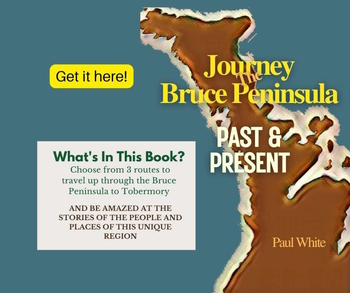Barn Raising: A Pioneer Economic and Social Necessity
Barn Raising: A Pioneer Economic and Social Necessity as it provided settlers with an opportunity not only to build a barn, but also build a community.
The settlers in Grey and Bruce counties faced many ordeals in their attempts to make a new life. The harsh winters and lack of efficient transportation links with the rest of the colony led them to depend upon one another for survival. Many early journals and diaries report of food being shared when supplies were not available. Others report of helping each other to clear the land in order to meet the terms of their land grants.
The settlers quickly learned that co-operation among relatives, friends and neighbours was the key to making life in the Grey and Bruce wilderness a little easier. Skills, tools and simply a helping hand made an arduous task a simpler. Pioneer life was essentially a cashless society. Consequently, neighbours soon learned to trade goods and services for assistance.
These circumstances led to an event that became popular in the long hot summer. Every farmer needed a barn and the logistics of building a structure large enough to house animals and feed was often far beyond the abilities of a few friends and neighbors. Consequently, out of this situation came the 'barn raising".
"Barn raising" proved to be more than just a laborious task. It became a cause for celebration and a break from the tedious, back-breaking toil of survival on the frontier wilderness.
Weeks before the event, the settler would discuss with his immediate neighbours the possibility of building a bam and decide upon an appropriate date. 'Then, the word was passed that on a certain day there would be a barn raising.
In the days leading up to the event, not only would the necessary construction supplies be gathered, but the women of the area would start preparing food to fuel the energy of the workers.
The day before the raising, wooden tables and, if available, a quantity of chairs would be set up around the house. The last-minute details, and chores were completed. The next morning, all of the settlers in the area would rise earlier than usual, and, after completing their daily chores they would head to the farm where the bam was to be built.
The volunteers were divided into teams and group leaders were selected. Each group was assigned a specific task and, before long, the air was alive with the sounds of hammers, hammering and saws ripping through the wood. At the lunch break, the efforts of the morning would be surveyed, and plans were made for the afternoon's work.
Despite. the lack of modern, efficient tools and help that may not have always been the most skilled, by the end of the day, the walls and the roof were in place. Except for some finishing touches, by nightfall, a new barn had taken its place on the landscape of the area.
Although the workers were tired from the hard days work, they did not head for home immediately after the job was completed. Instead, it was party time. Musical instruments were taken out and a dance was soon under way. The tables were loaded with food and the party often lasted well into the night.
Often, one bam raising was the occasion for the planning of another. Although it was hard work, barn raising provided the means of not only helping a neighbor build a barn, but also a respite from the day-to-day trials and tribulations of pioneer life in Grey and Bruce counties. Barn raising also helped to build a sense of community among pioneers who may have come from many different areas across the Atlantic.
A version of this article originally appeared in my Local History column in the Owen Sound Sun Times.
More Grey County Pages
12-year-old Walks to Owen Sound in 1851 from the journal of a teenage boy's experience travelling with his brother in the untamed Upper Canadian wilderness.
1st Grey County Building in 1852 was only built after many hurdles were overcame.
Dr. Anna Henry from Markdale, was a medical trailblazer for women doctors in Canada, who helped lay the groundwork for the establishment for Women's College Hospital.
Egremont Township endured the usual growing pains of a pioneer community, but its early history records times when it was embroiled in a few contentious issues.
Euphrasia Township in the early years when spelling the name was a problem for those who called it home and those that wanted settle this new Grey County township.
Georgian Bay's 1st pioneer settler arrived on the western shoreline long before any other settler reached the area.
Grey County Heritage: A Valuable Resource which is rich and varied, as an important resource for future use for business, political, and many other purposes.
Grey County's Creation in 1852, laid the framework for organizing a county in the last wilderness in the southern region of what would become in the future the province of Ontario.
An Unlikely Hero From Grey County (Part 1) found his way from the farming community of Flesherton to missionary work in the Ottawa Valley, and beyond.
An Unlikely Hero Vs. The KKK (Part 2) Our hero from Grey County took his missionary zeal south of the border and ultimately crossed paths with the infamous KKK!
Barn Raising: A Pioneer Economic and Social Necessity as it provided settlers with an opportunity not only to build a barn, but also build a community.
"Barring Out": A Pioneer School Tradition was a custom which the settlers brought to the new world from England, or Scotland.
Ceylon Ontario: How it Got its Name: It is always interesting how a community got its name, but I doubt any place received its name from a more unique source!
Chatsworth Ontario: First Settlers took advantage of fulfilling the needs of pioneer travellers and built a thriving community in the Upper Canadian wilderness.
Clearing Trees a Daunting Task for Settlers as they worked to fulfill their obligations for their land grant.
Dornoch: or is it Smithville? Originally it was Smithville, then it became Dornoch. But, surprise it is still, in reality Smithville!
First Pioneer in Durham: Archibald Hunter established his family, and a hotel, in what would become the centre of the town of Durham.
Durham Ontario Influenced by the Saugeen River. This river provided a means to create new industries, but especially in the spring it can also pose a menace to the community.
Grey County Bylaws to the 1890s reveal a lot about the financing of local government, especially education in the early days of the region.
John Muir, the legendary naturalist, who promoted the idea of protected nature spaces, spent time in Ontario and I went to help find evidence of his stay in the Owen Sound area.
A Heroic Woman From Grey County who made great changes as a doctor in China in the 1890s and early 1900s.
Jesse James: In Grey County? An interesting question. Did the notorious gangster hide out in Proton Township? We will never know. But it is fun to speculate!
Kilsyth's Train Engine was one for the history books. It brought an evening of joy followed by disappointing news soon after.
The Knight's of Meaford have long history in that Grey County community. Their business forged by early settlers employed many locals and supported the economy.
Leith: Tom Thomson's Birthplace is part of the rich heritage of this community located on the east shore of the Georgian Bay north of Owen Sound.
The Leith Golf Course has provided many families with great memories. The history of this golf course starts, and ends, with the generosity of one family.
Agnes Macphail was a political trailblazer in a part of Ontario that one could hardly expect such radical action for the era in a rural region.
Markdale Ontario: The Beginning: originally known as Glenelg East, but the coming of the railway and the name of owner of the land for the station led to a change of identity.
Meaford's history is one of hardy and entrepreneurial pioneers carving their lives out of the wilderness of what would become Grey County.
Meaford Ontario, first called Peggy's Landing located on the shores of Georgian Bay has a rich history.
Meaford vs Purdytown. Conflict over the name of a new community was not unusual in early Grey County but electing a school trustee was the "hot button" issue in this rivalry.
Pioneer Clergyman: John Neelands was the first to minister to the first settlers' spiritual needs riding on horseback through the wilds of early Grey County.
Pioneer Doctor: Dr. James Smith, a local boy who became a doctor and served his community for his entire life was a testament to Grey County community spirit.
Pioneer Healthcare in Grey and Bruce counties was not administered by doctors, nurses, or pharmacists, no it was the responsibility of the women of the community.
Pioneer Homes in Grey County in the 1840s offered only basic amenities. Homes were basic because clearing the land to earn a living to survive were of paramount importance for those embarking on a new life.
Pioneer Ingenuity created many labour saving devices and methods and quite often helped to create a sense of community.
Pioneer Christmas: A Family Tradition as told to me by may grandparents who experienced Christmas as children in the 1880s and 1890s.
Pioneer Settlement Plans for Grey County began almost two decades before the rest of Grey County was available for settlement.
A pioneer road surveyor's impact on the local history of Grey and Bruce counties could have been dramatic, if it had not been changed by another surveyor.
Pioneer Teachers in Grey and Bruce Counties had a long and arduous task, not to mentions strict and confining job requirements for very little salary.
Plowing Match in Grey County in 1933 the first International Plowing Match held in Grey and Bruce counties and it's success led to more such events in Grey.
Settling Osprey Township: Parts of Osprey were considered too rugged to settle, but today they are prime real estate because of the great view!
Swamp College: Proton Township: this colourfully named institution of education in Grey County has provided many stories to the heritage of the region.
Sydenham Township's First Council undertook the often difficult task of creating a new municipal infrastructure.
The Impact of Snow is not what is Used to be! As snow removal equipment has improved the impact of snow on our lives has reduced significantly from previous eras.
Unique Characters: Nathaniel Herriman lived in Grey County and owned an inn to provide food and and accommodation to early travellers. Each day he performed a unique practice.
Unique Maps: Quilts Guided the Underground Railroad to enable runaway slaves to escape to Canada and freedom from the shackles that enslaved them.
The Women's Institute is a group of rural women that has made a difference to the quality of both urban and rural life in Grey County and across the country.





